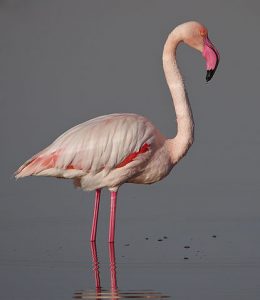Common Birds of Muttukadu & Kovalam
Resident Birds
Little Cormorant
The little cormorant (Microcarbo niger) is a member of the cormorant family of seabirds. Slightly smaller than the Indian cormorant it lacks a peaked head and has a shorter beak. It is widely distributed across the Indian Subcontinent and extends east to Java, where it is sometimes called the Javanese cormorant.
It forages singly or sometimes in loose groups in lowland freshwater bodies, including small ponds, large lakes, streams and sometimes coastal estuaries. Like other cormorants, it is often found perched on a waterside rock with its wings spread out after coming out of the water. The entire body is black in the breeding season but the plumage is brownish, and the throat has a small whitish patch in the non-breeding season. These birds breed gregariously in trees, often joining other waterbirds at heronries.

Spot-Billed Pelican
The spot-billed pelican or grey pelican (Pelecanus philippensis) is a member of the pelican family. It breeds in southern Asia from southern Pakistan across India east to Indonesia. It is a bird of large inland and coastal waters, especially large lakes. At a distance they are difficult to differentiate from other pelicans in the region although it is smaller but at close range the spots on the upper mandible, the lack of bright colours and the greyer plumage are distinctive. In some areas these birds nest in large colonies close to human habitations.

Little Grebe
The little grebe (Tachybaptus ruficollis), also known as dabchick, is a member of the grebe family of water birds. The genus name is from Ancient Greek takhus “fast” and bapto “to sink under”. The specific ruficollis is from Latin rufus “red” and Modern Latin -collis, “-necked”, itself derived from Latin collum “neck”.
At 23 to 29 cm (9.1 to 11.4 in) in length it is the smallest European member of its family. It is commonly found in open bodies of water across most of its range.

Common Kingfisher
The common kingfisher (Alcedo atthis) also known as the Eurasian kingfisher, and river kingfisher, is a small kingfisher with seven subspecies recognized within its wide distribution across Eurasia and North Africa. It is resident in much of its range, but migrates from areas where rivers freeze in winter.
This sparrow-sized bird has the typical short-tailed, large-headed kingfisher profile; it has blue upperparts, orange underparts and a long bill. It feeds mainly on fish, caught by diving, and has special visual adaptations to enable it to see prey under water. The glossy white eggs are laid in a nest at the end of a burrow in a riverbank.
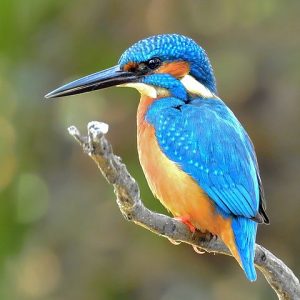
Pied Kingfisher
The pied kingfisher (Ceryle rudis) is a water kingfisher and is found widely distributed across Africa and Asia. Originally described by Linnaeus in 1758, it has five recognised subspecies. Its black and white plumage, crest and the habit of hovering over clear lakes and rivers before diving for fish make it distinctive. Males have a double band across the breast while females have a single gorget that is often broken in the middle. They are usually found in pairs or small family parties. When perched, they often bob their head and flick up their tail.
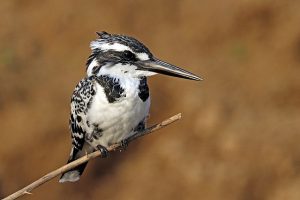
White-Throated Kingfisher
The white-throated kingfisher (Halcyon smyrnensis) also known as the white-breasted kingfisher is a tree kingfisher, widely distributed in Asia from Turkey east through the Indian subcontinent to the Philippines. This kingfisher is a resident over much of its range, although some populations may make short distance movements. It can often be found well away from water where it feeds on a wide range of prey that includes small reptiles, amphibians, crabs, small rodents and even birds. During the breeding season they call loudly in the mornings from prominent perches including the tops of buildings in urban areas or on wires.
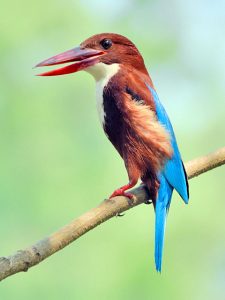
Little Green Bee-Eater
The green bee-eater (Merops orientalis) (sometimes little green bee-eater) is a near passerine bird in the bee-eater family. It is resident but prone to seasonal movements and is found widely distributed across sub-Saharan Africa from Senegal and the Gambia to Ethiopia, the Nile valley, western Arabia and Asia through India to Vietnam. They are mainly insect eaters and they are found in grassland, thin scrub and forest often quite far from water. Several regional plumage variations are known and several subspecies have been named.

Black Drongo
The black drongo (Dicrurus macrocercus) is a small Asian passerine bird of the drongo family Dicruridae. It is a common resident breeder in much of tropical southern Asia from southwest Iran through India and Sri Lanka east to southern China and Indonesia.
It is a wholly black bird with a distinctive forked tail and measures 28 cm (11 in) in length. It feeds on insects, and is common in open agricultural areas and light forest throughout its range, perching conspicuously on a bare perch or along power or telephone lines.
The species is known for its aggressive behaviour towards much larger birds, such as crows, never hesitating to dive-bomb any bird of prey that invades its territory. This behaviour earns it the informal name of king crow. Smaller birds often nest in the well-guarded vicinity of a nesting black drongo.

Red-Wattled Lapwing
The red-wattled lapwing (Vanellus indicus) is an Asian lapwing or large plover, a wader in the family Charadriidae. Like other lapwings they are ground birds that are incapable of perching.
Their characteristic loud alarm calls are indicators of human or animal movements and the sounds have been variously rendered as did he do it or pity to do it leading to the colloquial name of did-he-do-it bird.
Usually seen in pairs or small groups and usually not far from water they sometimes form large aggregations in the non-breeding season (winter). They nest in a ground scrape laying three to four camouflaged eggs. Adults near the nest fly around, diving at potential predators while calling noisily. The cryptically patterned chicks hatch and immediately follow their parents to feed, hiding by lying low on the ground or in the grass when threatened.
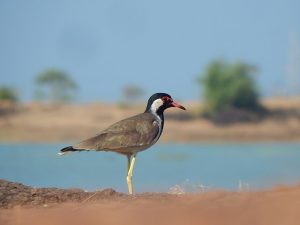
Pond Heron
The Indian pond heron or paddybird (Ardeola grayii) is a small heron. It is of Old World origins, breeding in southern Iran and east to Pakistan, India, Burma, Bangladesh and Sri Lanka. They are widespread and common but can be easily missed when they stalk prey at the edge of small water-bodies or even when they roost close to human habitations. They are however distinctive when they take off with bright white wings flashing in contrast to the cryptic streaked olive and brown colours of the body. Their camouflage is so excellent that they can be approached closely before they take to flight, a behaviour which has resulted in folk names and beliefs that the birds are short-sighted or blind.

Winter Migrants
Common Tern
The common tern (Sterna hirundo) is a seabird in the family Laridae. This bird has a circumpolar distribution, its four subspecies breeding in temperate and subarctic regions of Europe, Asia and North America. It is strongly migratory, wintering in coastal tropical and subtropical regions.
Breeding adults have light grey upperparts, white to very light grey underparts, a black cap, orange-red legs, and a narrow pointed bill. Depending on the subspecies, the bill may be mostly red with a black tip or all black. There are a number of similar species, including the partly sympatric Arctic tern, which can be separated on plumage details, leg and bill colour, or vocalisations.
Breeding in a wider range of habitats than any of its relatives, the common tern nests on any flat, poorly vegetated surface close to water, including beaches and islands, and it readily adapts to artificial substrates such as floating rafts. The nest may be a bare scrape in sand or gravel, but it is often lined or edged with whatever debris is available. Up to three eggs may be laid, their dull colours and blotchy patterns providing camouflage on the open beach. Incubation is by both sexes, and the eggs hatch in around 21–22 days, longer if the colony is disturbed by predators.
The downy chicks fledge in 22–28 days.
Like most terns, this species feeds by plunge-diving for fish, either in the sea or in freshwater, but molluscs, crustaceans and other invertebrate prey may form a significant part of the diet in some areas.
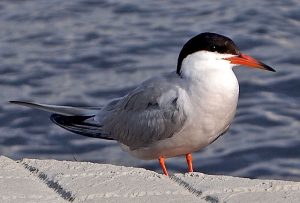
Little Tern
The little tern (Sternula albifrons) is a seabird of the family, Laridae. It was formerly placed into the genus Sterna, which now is restricted to the large white terns. The genus name is a diminutive of Sterna, “tern”. The specific albifrons is from Latin albus, “white”, and “frons”, forehead.
This bird breeds on the coasts and inland waterways of temperate and tropical Europe and Asia. It is strongly migratory, wintering in the subtropical and tropical oceans as far south as South Africa and Australia.
The little tern breeds in colonies on gravel or shingle coasts and islands. It lays two to four eggs on the ground. Like all white terns, it is defensive of its nest and young and will attack intruders. Like most other white terns, the little tern feeds by plunge-diving for fish, usually from saline environments. The offering of fish by the male to the female is part of the courtship display. This is a small tern, 21–25 cm long with a 41–47 cm wingspan.

Whiskered Tern
The whiskered tern (Chlidonias hybrida) is a tern in the family Laridae. The genus name is from Ancient Greek khelidonios, “swallow-like”, from khelidon, “swallow”.
This species breeds in colonies on inland marshes, sometimes amongst black-headed gulls, which provide some protection. The scientific name arises from the fact that this, the largest marsh tern, show similarities in appearance to both the white Sterna terns and to black tern.

Gull-Billed Tern
The gull-billed tern (Gelochelidon nilotica), formerly Sterna nilotica, is a tern in the family Laridae. It is now considered to be in its own genus. The genus name is from Ancient Greek gelao, “to laugh”, and khelidon, “swallow”. The specific niloticus is from Latin and means of the Nile.
This is a fairly large and powerful tern, similar in size and general appearance to a Sandwich tern, but the short thick gull-like bill, broad wings, long legs and robust body are distinctive. The summer adult has grey upperparts, white underparts, a black cap, strong black bill and black legs.
In winter, the cap is lost, and there is a dark patch through the eye like a Forster’s tern or a Mediterranean gull. Juvenile gull-billed terns have a fainter mask, but otherwise look much like winter adults.

Great Crested Tern
The greater crested tern (Thalasseus bergii), also called crested tern or swift tern, is a tern in the family Laridae that nests in dense colonies on coastlines and islands in the tropical and subtropical Old World. Its five subspecies breed in the area from South Africa around the Indian Ocean to the central Pacific and Australia, all populations dispersing widely from the breeding range after nesting. This large tern is closely related to the royal and lesser crested terns, but can be distinguished by its size and bill colour.
The greater crested tern has grey upperparts, white underparts, a yellow bill, and a shaggy black crest that recedes in winter. Its young have a distinctive appearance, with strongly patterned grey, brown and white plumage, and rely on their parents for food for several months after they have fledged. Like all members of the genus Thalasseus, the greater crested tern feeds by plunge diving for fish, usually in marine environments; the male offers fish to the female as part of the courtship ritual.
This is an adaptable species that has learned to follow fishing boats for jettisoned bycatch, and to use unusual nest sites such as the roofs of buildings and artificial islands in salt pans and sewage works. Its eggs and young are taken by gulls and ibises, and human activities such as fishing, shooting and egg harvesting have caused local population declines. There are no global conservation concerns for this bird, which has a stable total population of more than 500,000 individuals.
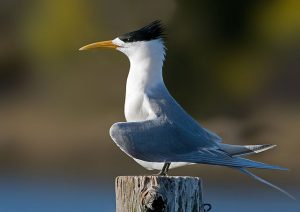
Sandwich Tern
The Sandwich tern (Thalasseus sandvicensis) is a tern in the family Laridae. It is very closely related to the lesser crested tern (T. bengalensis), Chinese crested tern (T. bernsteini), Cabot’s tern (T. acuflavidus), and elegant tern (T. elegans) and has been known to interbreed with the lesser crested.
The Sandwich tern is a medium-large tern with grey upperparts, white underparts, a yellow-tipped black bill and a shaggy black crest which becomes less extensive in winter with a white crown. Young birds bear grey and brown scalloped plumage on their backs and wings. It is a vocal bird. It nests in a ground scrape and lays one to three eggs.
Like all Thalasseus terns, the Sandwich tern feeds by plunge diving for fish, usually in marine environments, and the offering of fish by the male to the female is part of the courtship display.
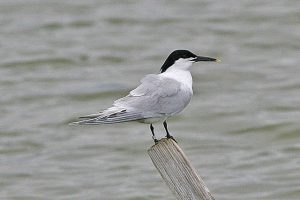
White-Winged Black Tern
The white-winged tern, or white-winged black tern (Chlidonias leucopterus or Chlidonias leucoptera), is a species of tern in the family Laridae. It is a small species generally found in or near bodies of fresh water across much of the world, including Europe, Africa, Asia, and Australia. The genus name is from Ancient Greek khelidonios, “swallow-like”, from khelidon, “swallow”. The specific leptopterus is also Greek from leptos, “slender”, and pteros, “feathered”, itself from pteron, “wing”.

Caspian Tern
The Caspian tern (Hydroprogne caspia) is a species of tern, with a subcosmopolitan but scattered distribution. Despite its extensive range, it is monotypic of its genus, and has no accepted subspecies. The genus name is from Ancient Greek hudros, “water”, and Latin progne, “swallow”. The specific caspia is from Latin and, like the English name, refers to the Caspian Sea.
Adult birds have black legs, and a long thick red-orange bill with a small black tip. They have a white head with a black cap and white neck, belly and tail. The upper wings and back are pale grey; the underwings are pale with dark primary feathers. In flight, the tail is less forked than other terns and wing tips black on the underside. In winter, the black cap is still present (unlike many other terns), but with some white streaking on the forehead. The call is a loud heron-like croak.

Common Sandpiper
The common sandpiper (Actitis hypoleucos) is a small Palearctic wader. This bird and its American sister species, the spotted sandpiper (A. macularia), make up the genus Actitis. They are parapatric and replace each other geographically; stray birds of either species may settle down with breeders of the other and hybridize. Hybridization has also been reported between the common sandpiper and the green sandpiper, a basal species of the closely related shank genus Tringa.
The adult is 18–20 cm (7.1–7.9 in) long with a 32–35 cm (13–14 in) wingspan. It has greyish-brown upper parts, white underparts, short dark-yellowish legs and feet, and a bill with a pale base and dark tip. In winter plumage, they are duller and have more conspicuous barring on the wings, though this is still only visible at close range. Juveniles are more heavily barred above and have buff edges to the wing feathers.
This species is very similar to the slightly larger spotted sandpiper (A. macularia) in non-breeding plumage. But its darker legs and feet and the crisper wing pattern (visible in flight) tend to give it away, and of course they are only rarely found in the same location.
It is a gregarious bird and is seen in large flocks, and has the distinctive stiff-winged flight, low over the water, of Actitis waders. The common sandpiper breeds across most of temperate and subtropical Europe and Asia, and migrates to Africa, southern Asia and Australia in winter. The eastern edge of its migration route passes by Palau in Micronesia, where hundreds of birds may gather for a stop-over. They depart the Palau region for their breeding quarters around the last week of April to the first week of May.

Wood Sandpiper
The wood sandpiper (Tringa glareola) is a small wader. This Eurasian species is the smallest of the shanks, which are mid-sized long-legged waders of the family Scolopacidae. The genus name Tringa is the New Latin name given to the green sandpiper by Aldrovandus in 1599 based on Ancient Greek trungas, a thrush-sized, white-rumped, tail-bobbing wading bird mentioned by Aristotle. The specific glareola is from Latin glarea, ” gravel”.
It resembles a longer-legged and more delicate green (T. ochropus) or solitary sandpiper (T. solitaria) with a short fine bill, brown back and longer yellowish legs. It differs from the first of those species in a smaller and less contrasting white rump patch, while the solitary sandpiper has no white rump patch at all.
This bird is usually found on freshwater during migration and wintering. They forage by probing in shallow water or on wet mud, and mainly eat insects and similar small prey. T. glareola nests on the ground or uses an abandoned old tree nest of another bird, such as the fieldfare (Turdus pilaris). Four pale green eggs are laid between March and May.

Curlew Sandpiper
The curlew sandpiper (Calidris ferruginea) is a small wader that breeds on the tundra of Arctic Siberia. The genus name is from Ancient Greek kalidris or skalidris, a term used by Aristotle for some grey-coloured waterside birds. The specific ferruginea is from Latin ferrugo, ferruginis, “iron rust” referring to its colour in breeding plumage.
It is strongly migratory, wintering mainly in Africa, but also in south and southeast Asia and in Australasia. It is a vagrant to North America.
These birds are small waders, only slightly larger than dunlin at 19.5–21 cm (7.7–8.3 in) in length, but differ from dunlin in having a longer down-curved bill, longer neck and legs and a white rump. The breeding adult has patterned dark grey upperparts and brick-red underparts. In winter, this bird is pale grey above and white below, and shows an obvious white supercilium. Juveniles have a grey and brown back, a white belly .and a peach-coloured breast.

Terek Sandpiper
The Terek sandpiper (Xenus cinereus) is a small migratory Palearctic wader species, the only member of the genus Xenus. It is named after the Terek River which flows into the west of the Caspian Sea, as it was first observed around this area. The genus name Xenus is from Ancient Greek xenos stranger, and cinereus is Latin for “ash-grey” from cinis, cineris, “ashes”.
Slightly larger than the common sandpiper at 22–25 cm (8.7–9.8 in) length, its long upcurved bill – somewhat reminiscent of an avocet’s, but not as strongly curved – makes it very distinctive. As the scientific specific name implies, this wader has a grey back, face and breast in all plumages; a white supercilium may appear more or less distinct. The belly is whitish and the feet yellow; the bill has a yellowish base, with the rest being black.
The call is a high whistle.

Eurasian Curlew
The Eurasian curlew (Numenius arquata) is a wader in the large family Scolopacidae. It is one of the most widespread of the curlews, breeding across temperate Europe and Asia. In Europe, this species is often referred to just as the “curlew”, and in Scotland known as the “whaup” in Scots.
This is the largest wader in its range, at 50–60 cm (20–24 in) in length, with an 89–106 cm (35–42 in) wingspan and a body weight of 410–1,360 g (0.90–3.00 lb). It is mainly greyish brown, with a white back, greyish-blue legs and a very long curved bill.
Males and females look identical, but the bill is longest in the adult female. It is generally not possible to recognize the sex of a single Eurasian curlew, or even several ones, as there is much variation; telling male and female of a mated pair apart is usually possible however.
The familiar call is a loud curloo-oo.
The curlew exists as a migratory species over most of its range, wintering in Africa, southern Europe and south Asia. Occasionally a vagrant individual reaches places far from its normal range, such as Nova Scotia and the Marianas. It is present all year in the milder climates of Ireland and the United Kingdom and its adjacent European coasts.

Whimbrel
The whimbrel (Numenius phaeopus) is a wader in the large family Scolopacidae. It is one of the most widespread of the curlews, breeding across much of subarctic North America, Europe and Asia as far south as Scotland.
This is a migratory species wintering on coasts in Africa, South America, south Asia into Australasia and southern North America. It is also a coastal bird during migration. It is fairly gregarious outside the breeding season.

Osprey
The osprey or more specifically the western osprey (Pandion haliaetus) — also called sea hawk, river hawk, and fish hawk — is a diurnal, fish-eating bird of prey with a cosmopolitan range. It is a large raptor, reaching more than 60 cm (24 in) in length and 180 cm (71 in) across the wings.
It is brown on the upperparts and predominantly greyish on the head and underparts.
The osprey tolerates a wide variety of habitats, nesting in any location near a body of water providing an adequate food supply. It is found on all continents except Antarctica, although in South America it occurs only as a non-breeding migrant.
As its other common names suggest, the osprey’s diet consists almost exclusively of fish. It possesses specialised physical characteristics and exhibits unique behaviour to assist in hunting and catching prey.

Little Stint
The little stint (Calidris minuta) (or Erolia minuta), is a very small wader. It breeds in arctic Europe and Asia, and is a long-distance migrant, wintering south to Africa and south Asia. It occasionally is a vagrant to North America and to Australia. The genus name is from Ancient Greek kalidris or skalidris, a term used by Aristotle for some grey-coloured waterside birds. The specific minuta is Latin for “small.
Its small size, fine dark bill, dark legs and quicker movements distinguish this species from all waders except the other dark-legged stints. It can be distinguished from these in all plumages by its combination of a fine bill tip, unwebbed toes and long primary projection. The call is a sharp “stit”.
The breeding adult has an orange wash to the breast, a white throat and a strong white V on its back. In winter plumage identification is difficult. Juveniles have pale crown stripes and a pinkish breast.

Temminck’s Stint
Temminck’s stint (Calidris temminckii) is a small wader. This bird’s common name and Latin binomial commemorate the Dutch naturalist Coenraad Jacob Temminck. The genus name is from Ancient Greek kalidris or skalidris, a term used by Aristotle for some grey-coloured waterside birds.
These birds are very small waders, at 13.5–15 cm (5.3–5.9 in) length. They are similar in size to the little stint (Calidris minuta) but shorter legged and longer winged. The legs are yellow and the outer tail feathers white, in contrast to little stint’s dark legs and grey outer tail feathers.
This is a rather drab wader, with mainly plain brown upperparts and head, and underparts white apart from a darker breast. The breeding adult has some brighter rufous mantle feathers to relieve the generally undistinguished appearance. In winter plumage, the general appearance recalls a tiny version of common sandpiper. The call is a loud trill.
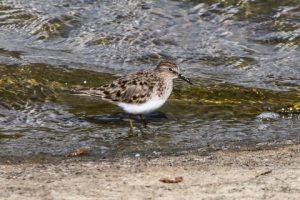
Dunlin
The dunlin (Calidris alpina) is a small wader, sometimes separated with the other “stints” in Erolia. The English name is a dialect form of “dunling”, first recorded in 1531–2. It derives from “dun”, “dull brown “, with the -ling suffix meaning “concerned with”. The genus name is from Ancient Greek kalidris or skalidris, a term used by Aristotle for some grey-coloured waterside birds. The specific alpina is from Latin and means “of high mountains”, in this case referring to the Alps.
It is a circumpolar breeder in Arctic or subarctic regions. Birds that breed in northern Europe and Asia are long-distance migrants, wintering south to Africa, southeast Asia and the Middle East. Birds that breed in Alaska and the Canadian Arctic migrate short distances to the Pacific and Atlantic coasts of North America, although those nesting in northern Alaska overwinter in Asia. Many dunlins winter along the Iberian south coast.

Black-Tailed Godwit
The black-tailed godwit (Limosa limosa) is a large, long-legged, long-billed shorebird first described by Carl Linnaeus in 1758. It is a member of the godwit genus, Limosa. There are three subspecies, all with orange head, neck and chest in breeding plumage and dull grey-brown winter coloration, and distinctive black and white wingbar at all times.
Its breeding range stretches from Iceland through Europe and areas of central Asia. Black-tailed godwits spend (the northern hemisphere) winter in areas as diverse as the Indian Subcontinent, Australia, New Zealand, western Europe and west Africa. The species breeds in fens, lake edges, damp meadows, moorlands and bogs and uses estuaries, swamps and floods in (the northern hemisphere) winter; it is more likely to be found inland and on freshwater than the similar bar-tailed godwit. The world population is estimated to be 634,000 to 805,000 birds and is classified as Near Threatened.

Common Redshank
The common redshank or simply redshank (Tringa totanus) is a Eurasian wader in the large family Scolopacidae. The genus name Tringa is the New Latin name given to the green sandpiper by Aldrovandus in 1599 based on Ancient Greek trungas, a thrush-sized, white-rumped, tail-bobbing wading bird mentioned by Aristotle. The specific totanus is from Tótano, the Italian name for this bird.
Common redshanks in breeding plumage are a marbled brown color, slightly lighter below. In winter plumage they become somewhat lighter-toned and less patterned, being rather plain greyish-brown above and whitish below. They have red legs and a black-tipped red bill, and show white up the back and on the wings in flight.

Greenshank
The common greenshank (Tringa nebularia) is a wader in the large family Scolopacidae, the typical waders. The genus name Tringa is the New Latin name given to the green sandpiper by Aldrovandus in 1599 based on Ancient Greek trungas, a thrush-sized, white-rumped, tail-bobbing wading bird mentioned by Aristotle. The specific nebularia is from Latin nebula “mist”. Like the Norwegian Skoddefoll, this refers to the greenshank’s damp marshy habitat.
Common greenshanks are brown in breeding plumage, and grey-brown in winter. When in water, they can appear very similar to marsh sandpipers but are distinguished by the shape of the lower bill which gives it an upturned appearance to the bill. They have long greenish legs and a long bill with a grey base. They show a white wedge on the back in flight. They are somewhat larger than the related common redshank. The usual call is a rapid series of three short fluty notes syllabilized as teu-teu-teu.

Painted Stork
The painted stork (Mycteria leucocephala) is a large wader in the stork family. It is found in the wetlands of the plains of tropical Asia south of the Himalayas in the Indian Subcontinent and extending into Southeast Asia.
Their distinctive pink tertial feathers of the adults give them their name. They forage in flocks in shallow waters along rivers or lakes. They immerse their half open beaks in water and sweep them from side to side and snap up their prey of small fish that are sensed by touch. As they wade along they also stir the water with their feet to flush hiding fish.
They nest colonially in trees, often along with other waterbirds. The only sounds they produce are weak moans or bill clattering at the nest. They are not migratory and only make short distance movements in some parts of their range in response to changes in weather or food availability or for breeding. Like other storks, they are often seen soaring on thermals.
This large stork has a heavy yellow beak with a down-curved tip that gives it a resemblance to an ibis. The head of the adult is bare and orange or reddish in colour. The long tertials are tipped in bright pink and at rest they extend over the back and rump. There is a distinctive black breast band with white scaly markings. The band continues into the underwing coverts and the white tips of the black coverts give it the appearance of white stripes running across the underwing lining.
The downy young are mainly whitish with grey bills and blackish facial skin. The juveniles assume a brownish plumage and like most other storks reach breeding condition after two to three years. Like all storks, they fly with their neck outstretched. They often make use of the late morning thermals to soar in search of foraging areas. Like other storks they are mostly silent but clatter their bills at nest and may make some harsh croaking or low moaning sounds at nest.

Openbill Stork
The Asian openbill or Asian openbill stork (Anastomus oscitans) is a large wading bird in the stork family Ciconiidae. This distinctive stork is found mainly in the Indian subcontinent and Southeast Asia. It is greyish or white with glossy black wings and tail and the adults have a gap between the arched upper mandible and recurved lower mandible. Young birds are born without this gap which is thought to be an adaptation that aids in the handling of snails, their main prey. Although resident within their range, they make long distance movements in response to weather and food availability.
The Asian openbill stork is predominantly greyish (non-breeding season) or white (breeding season) with glossy black wings and tail that have a green or purple sheen. The name is derived from the distinctive gap formed between the recurved lower and arched upper mandible of the beak in adult birds. Young birds do not have this gap. The cutting edges of the mandible have a fine brush like structure that is thought to give them better grip on the shells of snails. The tail consists of twelve feathers and the preen gland has a tuft. The mantle is black and the bill is horn-grey. At a distance, they can appear somewhat like a white stork or Oriental stork. The short legs are pinkish to grey, reddish prior to breeding. Non-breeding birds have a smoky grey wings and back instead of white. Young birds are brownish-grey and have a brownish mantle. Like other storks, the Asian openbill is a broad-winged soaring bird, which relies on moving between thermals of hot air for sustained flight. They are usually found in flocks but single birds are not uncommon. Like all storks, it flies with its neck outstretched. It is relatively small for a stork and stands at 68 cm height (81 cm long).
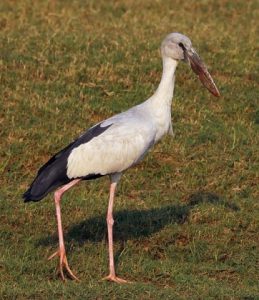
Grey Heron
The grey heron (Ardea cinerea) is a long-legged predatory wading bird of the heron family, Ardeidae, native throughout temperate Europe and Asia and also parts of Africa. It is resident in much of its range, but some populations from the more northern parts migrate southwards in autumn. A bird of wetland areas, it can be seen around lakes, rivers, ponds, marshes and on the sea coast. It feeds mostly on aquatic creatures which it catches after standing stationary beside or in the water or stalking its prey through the shallows.
Standing up to a metre tall, adults weigh from 1 to 2 kg (2.2 to 4.4 lb). They have a white head and neck with a broad black stripe that extends from the eye to the black crest. The body and wings are grey above and the underparts are greyish-white, with some black on the flanks. The long, sharply pointed beak is pinkish-yellow and the legs are brown.
The birds breed colonially in spring in “heronries”, usually building their nests high in trees. A clutch of usually three to five bluish-green eggs is laid. Both birds incubate the eggs for a period of about 25 days, and then both feed the chicks, which fledge when seven or eight weeks old. Many juveniles do not survive their first winter, but if they do, they can expect to live for about five years.

Greater Flamingo
The greater flamingo (Phoenicopterus roseus) is the most widespread and largest species of the flamingo family. It is found in Africa, on the Indian subcontinent, in the Middle East, and in southern Europe.
This is the largest species of flamingo, averaging 110–150 cm (43–59 in) tall and weighing 2–4 kg (4.4–8.8 lb). The largest male flamingos have been recorded at up to 187 cm (74 in) tall and 4.5 kg (9.9 lb). It is closely related to the American flamingo and Chilean flamingo, with which it has sometimes been considered conspecific.
Like all flamingos, this species lays a single chalky-white egg on a mud mound. Most of the plumage is pinkish white, but the wing coverts are red and the primary and secondary flight feathers are black. The bill is pink with a restricted black tip, and the legs are entirely pink. The call is a goose-like honking.
Subadult flamingos are whitish grey and only attain the pink coloration several years into their adult life. The coloration comes from the carotenoid pigments in the organisms that live in their feeding grounds.
The bird resides in mudflats and shallow coastal lagoons with salt water. Using its feet, the bird stirs up the mud, then sucks water through its bill and filters out small shrimp, seeds, blue-green algae, microscopic organisms, and mollusks.
